Wills and Estates Report: Australian Law and Asset Distribution
VerifiedAdded on 2020/06/06
|8
|2246
|81
Report
AI Summary
This report analyzes a wills and estates case concerning Alvin Tan's will, focusing on the distribution of his assets after his death. The report examines relevant Australian laws, including those pertaining to executors' duties, inheritance tax, and capital gains tax. It addresses the distribution of the residuary estate, the types of legacies (specifically those in clauses 2 and 3), and the types of grants made in the will. The application section discusses the distribution of assets among beneficiaries, including his godson Simon Temper and goddaughter Tania, considering their ages and the implications of Tania's minority. The report also references key legal cases, such as Stella Burnard v Graham Burnard and others, Watts v Watts, and Heather Ilot, to support its legal arguments and conclusions. It explores the tax implications for the beneficiaries, including exemptions and liabilities related to superannuation and inheritance. The analysis considers the impact of the executors' deaths and the subsequent transfer of responsibilities and benefits to other family members, concluding with a summary of the will's provisions and their practical effects.
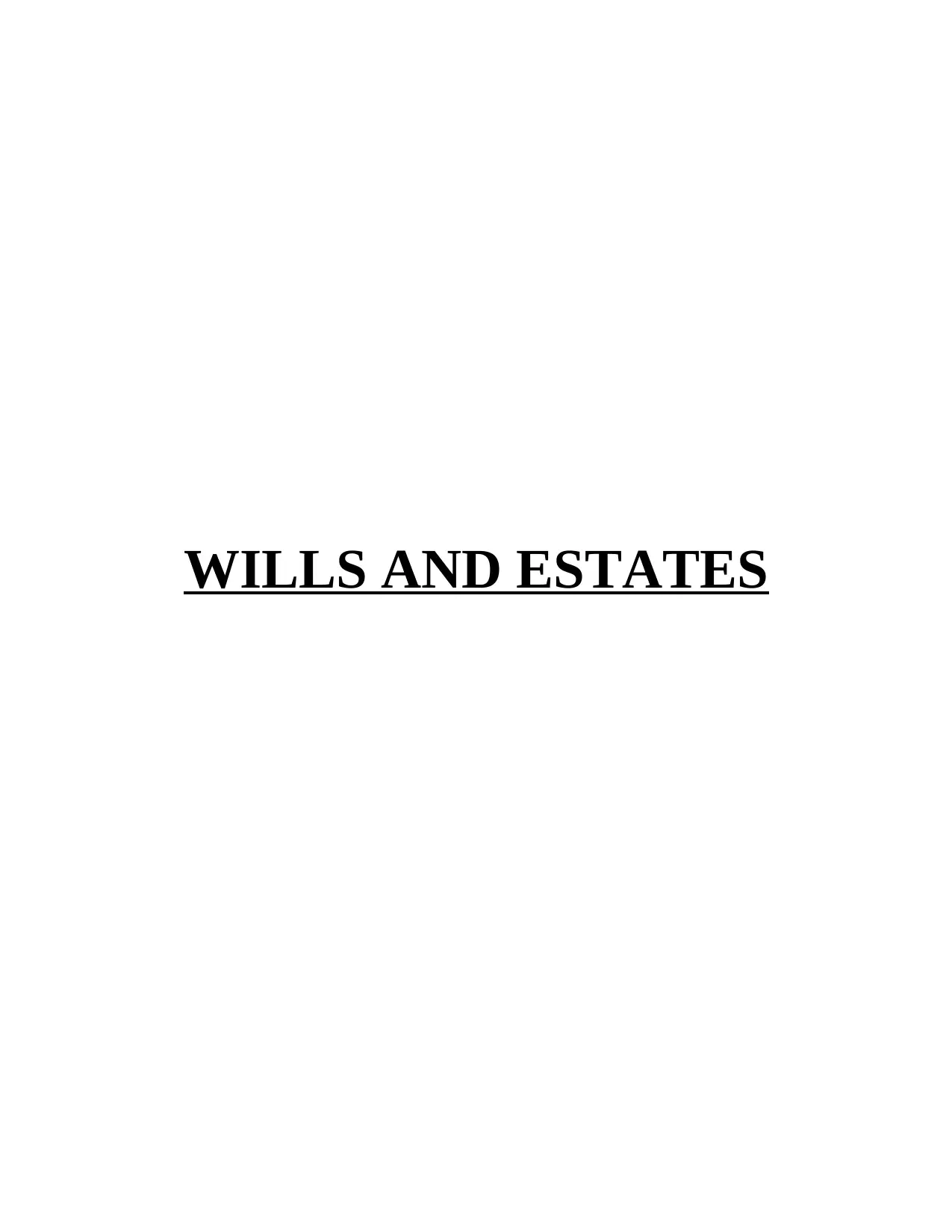
WILLS AND ESTATES
Paraphrase This Document
Need a fresh take? Get an instant paraphrase of this document with our AI Paraphraser
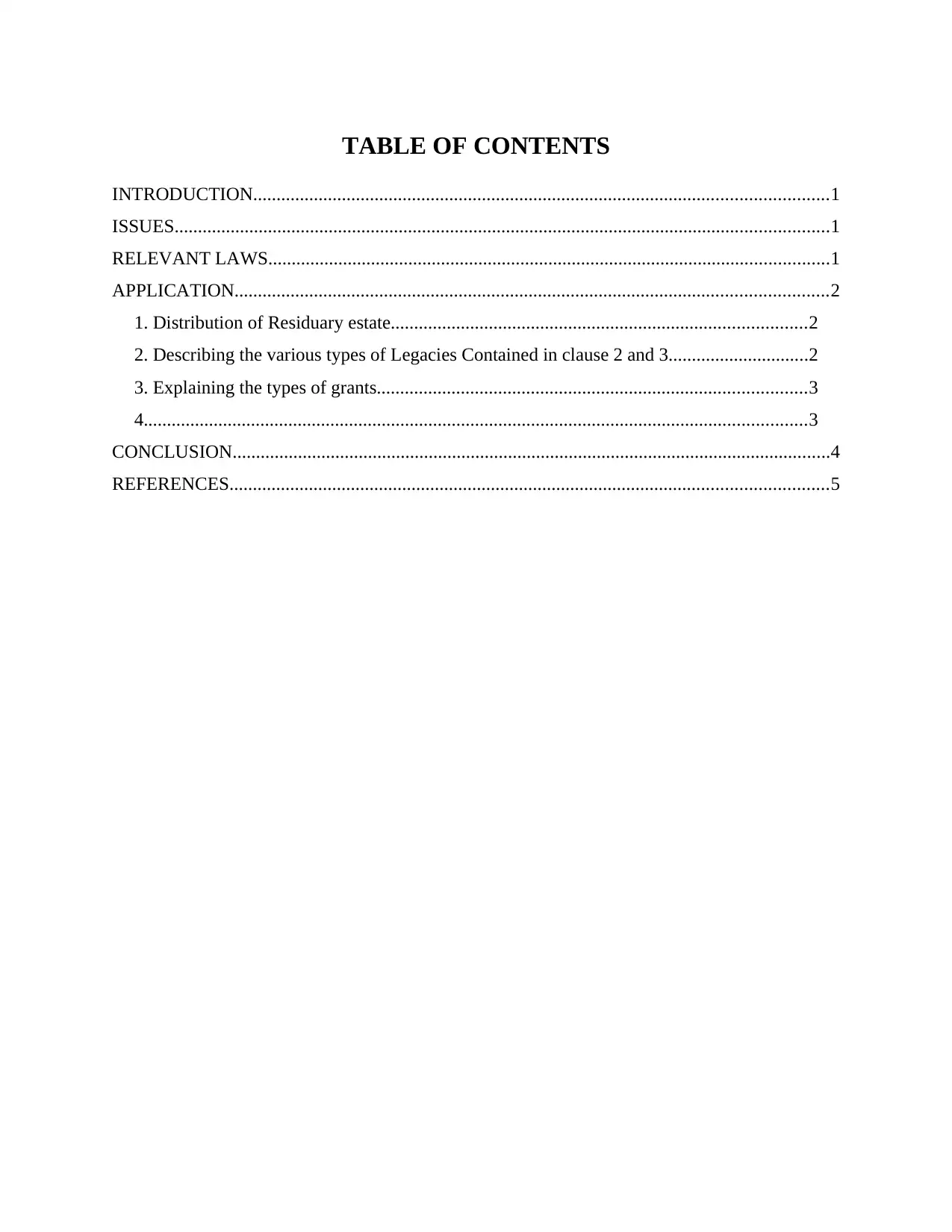
TABLE OF CONTENTS
INTRODUCTION...........................................................................................................................1
ISSUES............................................................................................................................................1
RELEVANT LAWS........................................................................................................................1
APPLICATION...............................................................................................................................2
1. Distribution of Residuary estate.........................................................................................2
2. Describing the various types of Legacies Contained in clause 2 and 3..............................2
3. Explaining the types of grants............................................................................................3
4..............................................................................................................................................3
CONCLUSION................................................................................................................................4
REFERENCES................................................................................................................................5
INTRODUCTION...........................................................................................................................1
ISSUES............................................................................................................................................1
RELEVANT LAWS........................................................................................................................1
APPLICATION...............................................................................................................................2
1. Distribution of Residuary estate.........................................................................................2
2. Describing the various types of Legacies Contained in clause 2 and 3..............................2
3. Explaining the types of grants............................................................................................3
4..............................................................................................................................................3
CONCLUSION................................................................................................................................4
REFERENCES................................................................................................................................5
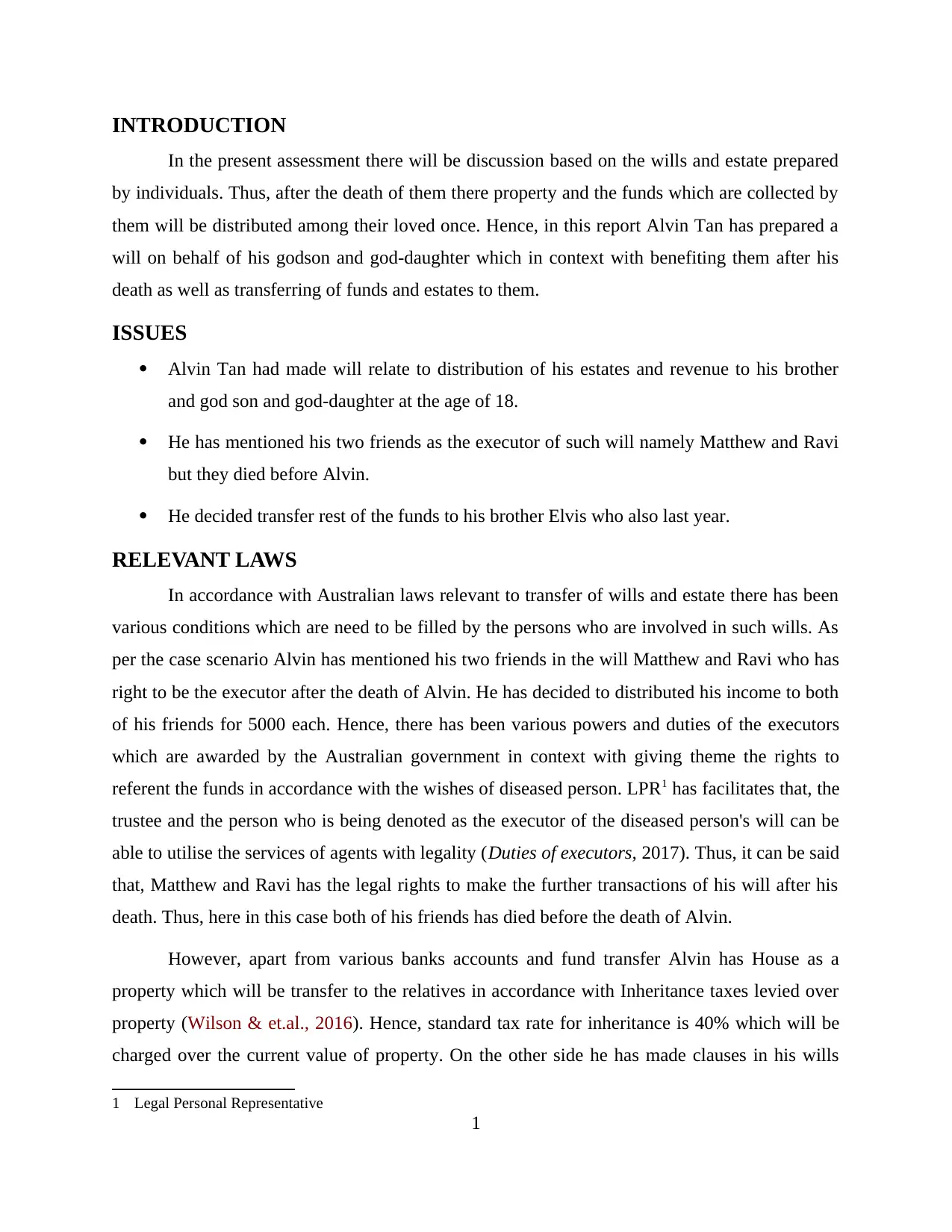
INTRODUCTION
In the present assessment there will be discussion based on the wills and estate prepared
by individuals. Thus, after the death of them there property and the funds which are collected by
them will be distributed among their loved once. Hence, in this report Alvin Tan has prepared a
will on behalf of his godson and god-daughter which in context with benefiting them after his
death as well as transferring of funds and estates to them.
ISSUES
Alvin Tan had made will relate to distribution of his estates and revenue to his brother
and god son and god-daughter at the age of 18.
He has mentioned his two friends as the executor of such will namely Matthew and Ravi
but they died before Alvin.
He decided transfer rest of the funds to his brother Elvis who also last year.
RELEVANT LAWS
In accordance with Australian laws relevant to transfer of wills and estate there has been
various conditions which are need to be filled by the persons who are involved in such wills. As
per the case scenario Alvin has mentioned his two friends in the will Matthew and Ravi who has
right to be the executor after the death of Alvin. He has decided to distributed his income to both
of his friends for 5000 each. Hence, there has been various powers and duties of the executors
which are awarded by the Australian government in context with giving theme the rights to
referent the funds in accordance with the wishes of diseased person. LPR1 has facilitates that, the
trustee and the person who is being denoted as the executor of the diseased person's will can be
able to utilise the services of agents with legality (Duties of executors, 2017). Thus, it can be said
that, Matthew and Ravi has the legal rights to make the further transactions of his will after his
death. Thus, here in this case both of his friends has died before the death of Alvin.
However, apart from various banks accounts and fund transfer Alvin has House as a
property which will be transfer to the relatives in accordance with Inheritance taxes levied over
property (Wilson & et.al., 2016). Hence, standard tax rate for inheritance is 40% which will be
charged over the current value of property. On the other side he has made clauses in his wills
1 Legal Personal Representative
1
In the present assessment there will be discussion based on the wills and estate prepared
by individuals. Thus, after the death of them there property and the funds which are collected by
them will be distributed among their loved once. Hence, in this report Alvin Tan has prepared a
will on behalf of his godson and god-daughter which in context with benefiting them after his
death as well as transferring of funds and estates to them.
ISSUES
Alvin Tan had made will relate to distribution of his estates and revenue to his brother
and god son and god-daughter at the age of 18.
He has mentioned his two friends as the executor of such will namely Matthew and Ravi
but they died before Alvin.
He decided transfer rest of the funds to his brother Elvis who also last year.
RELEVANT LAWS
In accordance with Australian laws relevant to transfer of wills and estate there has been
various conditions which are need to be filled by the persons who are involved in such wills. As
per the case scenario Alvin has mentioned his two friends in the will Matthew and Ravi who has
right to be the executor after the death of Alvin. He has decided to distributed his income to both
of his friends for 5000 each. Hence, there has been various powers and duties of the executors
which are awarded by the Australian government in context with giving theme the rights to
referent the funds in accordance with the wishes of diseased person. LPR1 has facilitates that, the
trustee and the person who is being denoted as the executor of the diseased person's will can be
able to utilise the services of agents with legality (Duties of executors, 2017). Thus, it can be said
that, Matthew and Ravi has the legal rights to make the further transactions of his will after his
death. Thus, here in this case both of his friends has died before the death of Alvin.
However, apart from various banks accounts and fund transfer Alvin has House as a
property which will be transfer to the relatives in accordance with Inheritance taxes levied over
property (Wilson & et.al., 2016). Hence, standard tax rate for inheritance is 40% which will be
charged over the current value of property. On the other side he has made clauses in his wills
1 Legal Personal Representative
1
⊘ This is a preview!⊘
Do you want full access?
Subscribe today to unlock all pages.

Trusted by 1+ million students worldwide
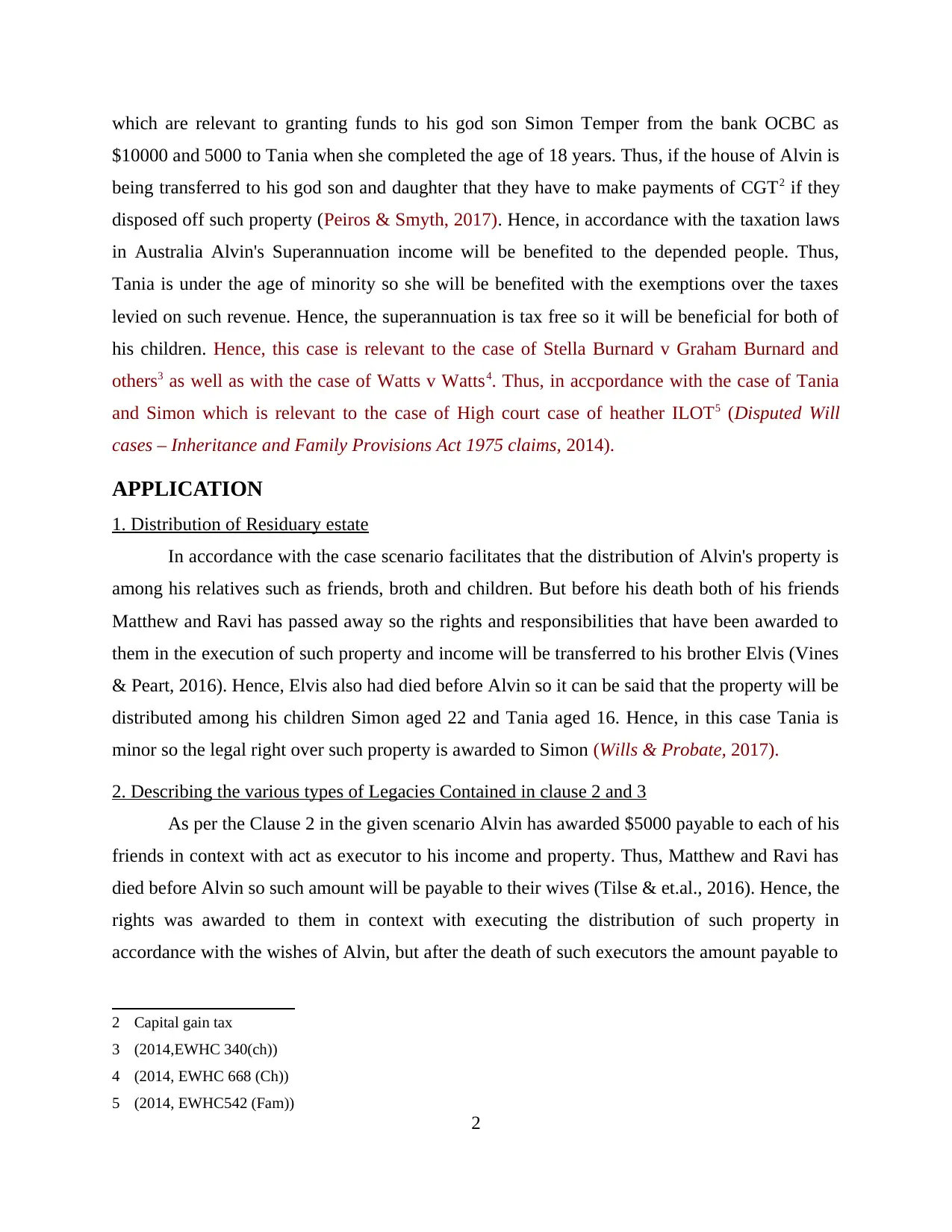
which are relevant to granting funds to his god son Simon Temper from the bank OCBC as
$10000 and 5000 to Tania when she completed the age of 18 years. Thus, if the house of Alvin is
being transferred to his god son and daughter that they have to make payments of CGT2 if they
disposed off such property (Peiros & Smyth, 2017). Hence, in accordance with the taxation laws
in Australia Alvin's Superannuation income will be benefited to the depended people. Thus,
Tania is under the age of minority so she will be benefited with the exemptions over the taxes
levied on such revenue. Hence, the superannuation is tax free so it will be beneficial for both of
his children. Hence, this case is relevant to the case of Stella Burnard v Graham Burnard and
others3 as well as with the case of Watts v Watts4. Thus, in accpordance with the case of Tania
and Simon which is relevant to the case of High court case of heather ILOT5 (Disputed Will
cases – Inheritance and Family Provisions Act 1975 claims, 2014).
APPLICATION
1. Distribution of Residuary estate
In accordance with the case scenario facilitates that the distribution of Alvin's property is
among his relatives such as friends, broth and children. But before his death both of his friends
Matthew and Ravi has passed away so the rights and responsibilities that have been awarded to
them in the execution of such property and income will be transferred to his brother Elvis (Vines
& Peart, 2016). Hence, Elvis also had died before Alvin so it can be said that the property will be
distributed among his children Simon aged 22 and Tania aged 16. Hence, in this case Tania is
minor so the legal right over such property is awarded to Simon (Wills & Probate, 2017).
2. Describing the various types of Legacies Contained in clause 2 and 3
As per the Clause 2 in the given scenario Alvin has awarded $5000 payable to each of his
friends in context with act as executor to his income and property. Thus, Matthew and Ravi has
died before Alvin so such amount will be payable to their wives (Tilse & et.al., 2016). Hence, the
rights was awarded to them in context with executing the distribution of such property in
accordance with the wishes of Alvin, but after the death of such executors the amount payable to
2 Capital gain tax
3 (2014,EWHC 340(ch))
4 (2014, EWHC 668 (Ch))
5 (2014, EWHC542 (Fam))
2
$10000 and 5000 to Tania when she completed the age of 18 years. Thus, if the house of Alvin is
being transferred to his god son and daughter that they have to make payments of CGT2 if they
disposed off such property (Peiros & Smyth, 2017). Hence, in accordance with the taxation laws
in Australia Alvin's Superannuation income will be benefited to the depended people. Thus,
Tania is under the age of minority so she will be benefited with the exemptions over the taxes
levied on such revenue. Hence, the superannuation is tax free so it will be beneficial for both of
his children. Hence, this case is relevant to the case of Stella Burnard v Graham Burnard and
others3 as well as with the case of Watts v Watts4. Thus, in accpordance with the case of Tania
and Simon which is relevant to the case of High court case of heather ILOT5 (Disputed Will
cases – Inheritance and Family Provisions Act 1975 claims, 2014).
APPLICATION
1. Distribution of Residuary estate
In accordance with the case scenario facilitates that the distribution of Alvin's property is
among his relatives such as friends, broth and children. But before his death both of his friends
Matthew and Ravi has passed away so the rights and responsibilities that have been awarded to
them in the execution of such property and income will be transferred to his brother Elvis (Vines
& Peart, 2016). Hence, Elvis also had died before Alvin so it can be said that the property will be
distributed among his children Simon aged 22 and Tania aged 16. Hence, in this case Tania is
minor so the legal right over such property is awarded to Simon (Wills & Probate, 2017).
2. Describing the various types of Legacies Contained in clause 2 and 3
As per the Clause 2 in the given scenario Alvin has awarded $5000 payable to each of his
friends in context with act as executor to his income and property. Thus, Matthew and Ravi has
died before Alvin so such amount will be payable to their wives (Tilse & et.al., 2016). Hence, the
rights was awarded to them in context with executing the distribution of such property in
accordance with the wishes of Alvin, but after the death of such executors the amount payable to
2 Capital gain tax
3 (2014,EWHC 340(ch))
4 (2014, EWHC 668 (Ch))
5 (2014, EWHC542 (Fam))
2
Paraphrase This Document
Need a fresh take? Get an instant paraphrase of this document with our AI Paraphraser
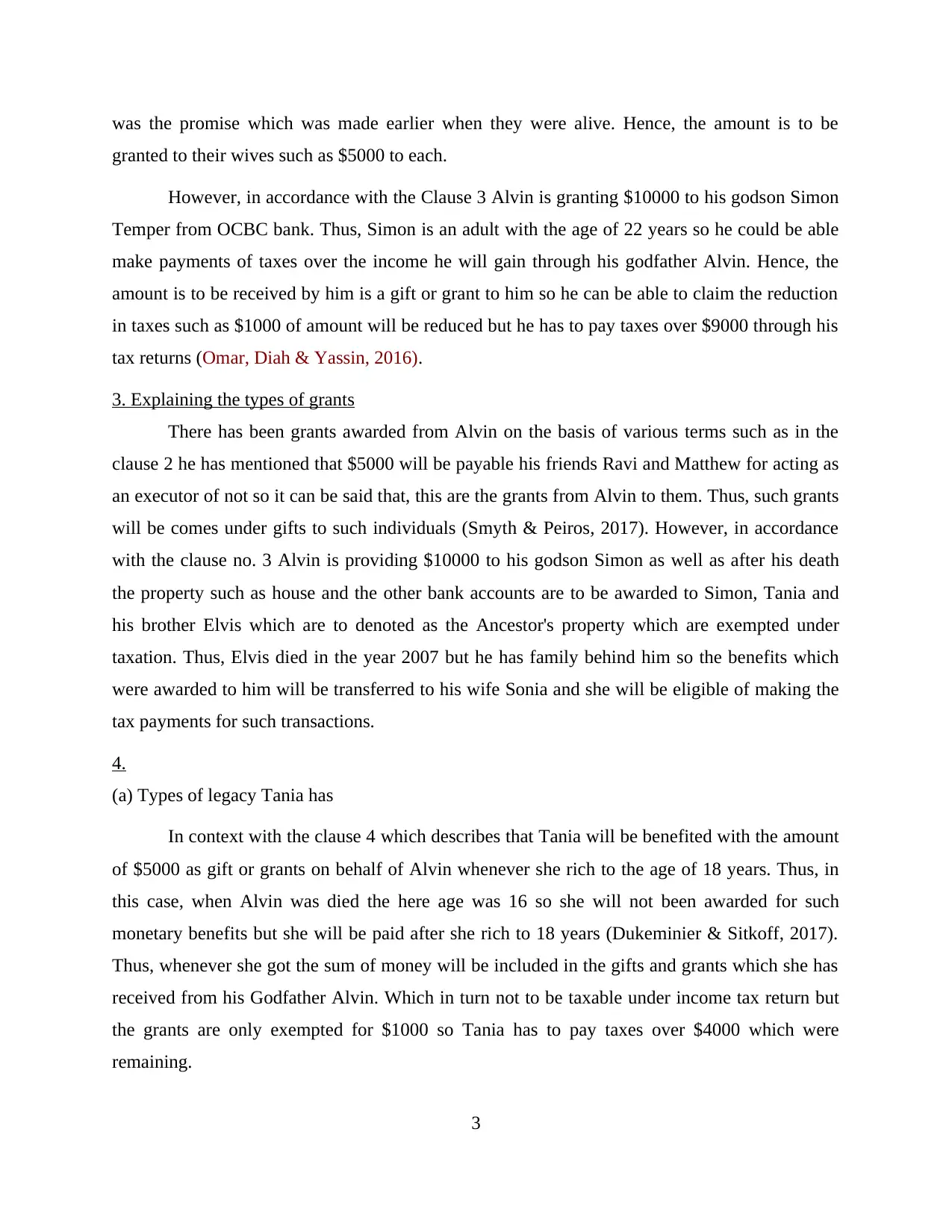
was the promise which was made earlier when they were alive. Hence, the amount is to be
granted to their wives such as $5000 to each.
However, in accordance with the Clause 3 Alvin is granting $10000 to his godson Simon
Temper from OCBC bank. Thus, Simon is an adult with the age of 22 years so he could be able
make payments of taxes over the income he will gain through his godfather Alvin. Hence, the
amount is to be received by him is a gift or grant to him so he can be able to claim the reduction
in taxes such as $1000 of amount will be reduced but he has to pay taxes over $9000 through his
tax returns (Omar, Diah & Yassin, 2016).
3. Explaining the types of grants
There has been grants awarded from Alvin on the basis of various terms such as in the
clause 2 he has mentioned that $5000 will be payable his friends Ravi and Matthew for acting as
an executor of not so it can be said that, this are the grants from Alvin to them. Thus, such grants
will be comes under gifts to such individuals (Smyth & Peiros, 2017). However, in accordance
with the clause no. 3 Alvin is providing $10000 to his godson Simon as well as after his death
the property such as house and the other bank accounts are to be awarded to Simon, Tania and
his brother Elvis which are to denoted as the Ancestor's property which are exempted under
taxation. Thus, Elvis died in the year 2007 but he has family behind him so the benefits which
were awarded to him will be transferred to his wife Sonia and she will be eligible of making the
tax payments for such transactions.
4.
(a) Types of legacy Tania has
In context with the clause 4 which describes that Tania will be benefited with the amount
of $5000 as gift or grants on behalf of Alvin whenever she rich to the age of 18 years. Thus, in
this case, when Alvin was died the here age was 16 so she will not been awarded for such
monetary benefits but she will be paid after she rich to 18 years (Dukeminier & Sitkoff, 2017).
Thus, whenever she got the sum of money will be included in the gifts and grants which she has
received from his Godfather Alvin. Which in turn not to be taxable under income tax return but
the grants are only exempted for $1000 so Tania has to pay taxes over $4000 which were
remaining.
3
granted to their wives such as $5000 to each.
However, in accordance with the Clause 3 Alvin is granting $10000 to his godson Simon
Temper from OCBC bank. Thus, Simon is an adult with the age of 22 years so he could be able
make payments of taxes over the income he will gain through his godfather Alvin. Hence, the
amount is to be received by him is a gift or grant to him so he can be able to claim the reduction
in taxes such as $1000 of amount will be reduced but he has to pay taxes over $9000 through his
tax returns (Omar, Diah & Yassin, 2016).
3. Explaining the types of grants
There has been grants awarded from Alvin on the basis of various terms such as in the
clause 2 he has mentioned that $5000 will be payable his friends Ravi and Matthew for acting as
an executor of not so it can be said that, this are the grants from Alvin to them. Thus, such grants
will be comes under gifts to such individuals (Smyth & Peiros, 2017). However, in accordance
with the clause no. 3 Alvin is providing $10000 to his godson Simon as well as after his death
the property such as house and the other bank accounts are to be awarded to Simon, Tania and
his brother Elvis which are to denoted as the Ancestor's property which are exempted under
taxation. Thus, Elvis died in the year 2007 but he has family behind him so the benefits which
were awarded to him will be transferred to his wife Sonia and she will be eligible of making the
tax payments for such transactions.
4.
(a) Types of legacy Tania has
In context with the clause 4 which describes that Tania will be benefited with the amount
of $5000 as gift or grants on behalf of Alvin whenever she rich to the age of 18 years. Thus, in
this case, when Alvin was died the here age was 16 so she will not been awarded for such
monetary benefits but she will be paid after she rich to 18 years (Dukeminier & Sitkoff, 2017).
Thus, whenever she got the sum of money will be included in the gifts and grants which she has
received from his Godfather Alvin. Which in turn not to be taxable under income tax return but
the grants are only exempted for $1000 so Tania has to pay taxes over $4000 which were
remaining.
3
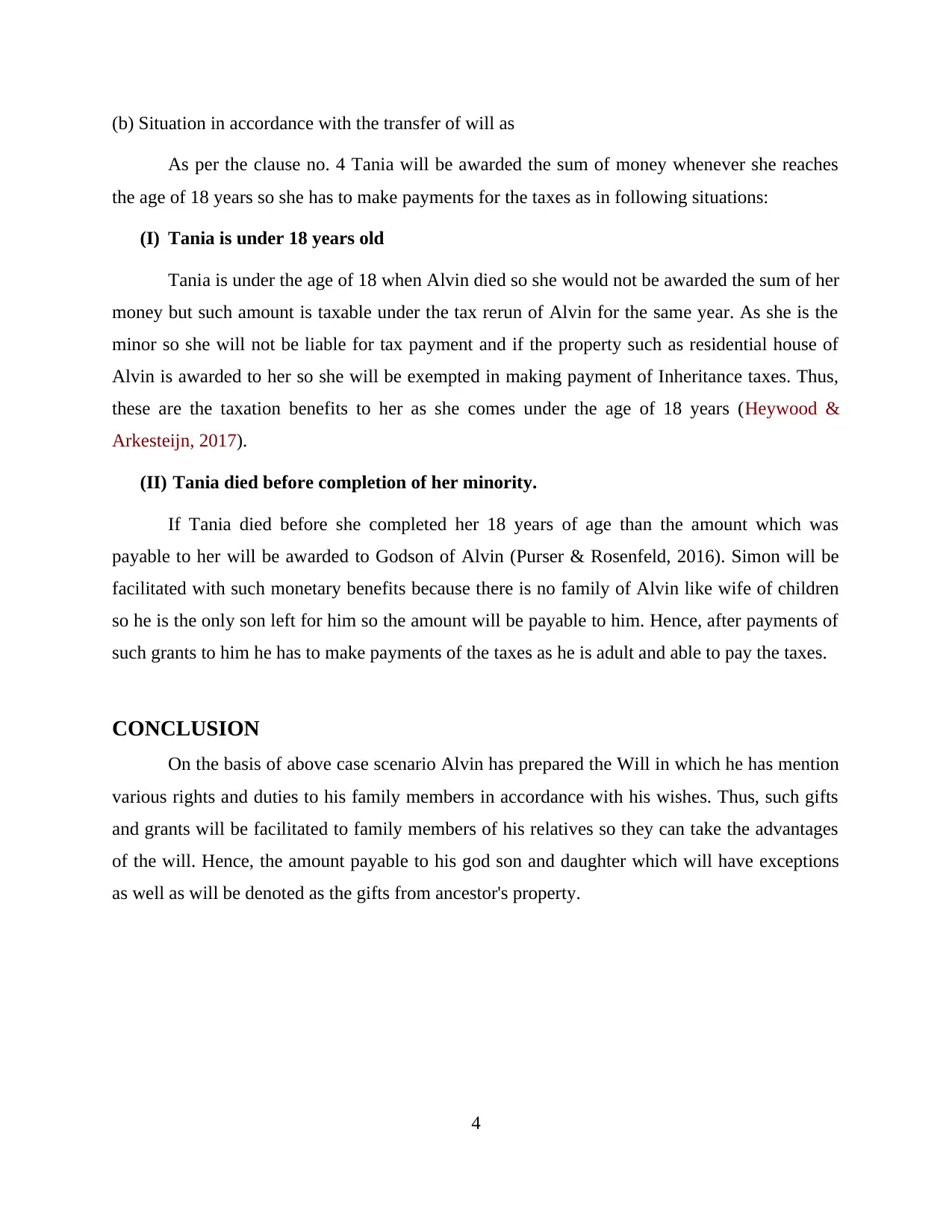
(b) Situation in accordance with the transfer of will as
As per the clause no. 4 Tania will be awarded the sum of money whenever she reaches
the age of 18 years so she has to make payments for the taxes as in following situations:
(I) Tania is under 18 years old
Tania is under the age of 18 when Alvin died so she would not be awarded the sum of her
money but such amount is taxable under the tax rerun of Alvin for the same year. As she is the
minor so she will not be liable for tax payment and if the property such as residential house of
Alvin is awarded to her so she will be exempted in making payment of Inheritance taxes. Thus,
these are the taxation benefits to her as she comes under the age of 18 years (Heywood &
Arkesteijn, 2017).
(II) Tania died before completion of her minority.
If Tania died before she completed her 18 years of age than the amount which was
payable to her will be awarded to Godson of Alvin (Purser & Rosenfeld, 2016). Simon will be
facilitated with such monetary benefits because there is no family of Alvin like wife of children
so he is the only son left for him so the amount will be payable to him. Hence, after payments of
such grants to him he has to make payments of the taxes as he is adult and able to pay the taxes.
CONCLUSION
On the basis of above case scenario Alvin has prepared the Will in which he has mention
various rights and duties to his family members in accordance with his wishes. Thus, such gifts
and grants will be facilitated to family members of his relatives so they can take the advantages
of the will. Hence, the amount payable to his god son and daughter which will have exceptions
as well as will be denoted as the gifts from ancestor's property.
4
As per the clause no. 4 Tania will be awarded the sum of money whenever she reaches
the age of 18 years so she has to make payments for the taxes as in following situations:
(I) Tania is under 18 years old
Tania is under the age of 18 when Alvin died so she would not be awarded the sum of her
money but such amount is taxable under the tax rerun of Alvin for the same year. As she is the
minor so she will not be liable for tax payment and if the property such as residential house of
Alvin is awarded to her so she will be exempted in making payment of Inheritance taxes. Thus,
these are the taxation benefits to her as she comes under the age of 18 years (Heywood &
Arkesteijn, 2017).
(II) Tania died before completion of her minority.
If Tania died before she completed her 18 years of age than the amount which was
payable to her will be awarded to Godson of Alvin (Purser & Rosenfeld, 2016). Simon will be
facilitated with such monetary benefits because there is no family of Alvin like wife of children
so he is the only son left for him so the amount will be payable to him. Hence, after payments of
such grants to him he has to make payments of the taxes as he is adult and able to pay the taxes.
CONCLUSION
On the basis of above case scenario Alvin has prepared the Will in which he has mention
various rights and duties to his family members in accordance with his wishes. Thus, such gifts
and grants will be facilitated to family members of his relatives so they can take the advantages
of the will. Hence, the amount payable to his god son and daughter which will have exceptions
as well as will be denoted as the gifts from ancestor's property.
4
⊘ This is a preview!⊘
Do you want full access?
Subscribe today to unlock all pages.

Trusted by 1+ million students worldwide
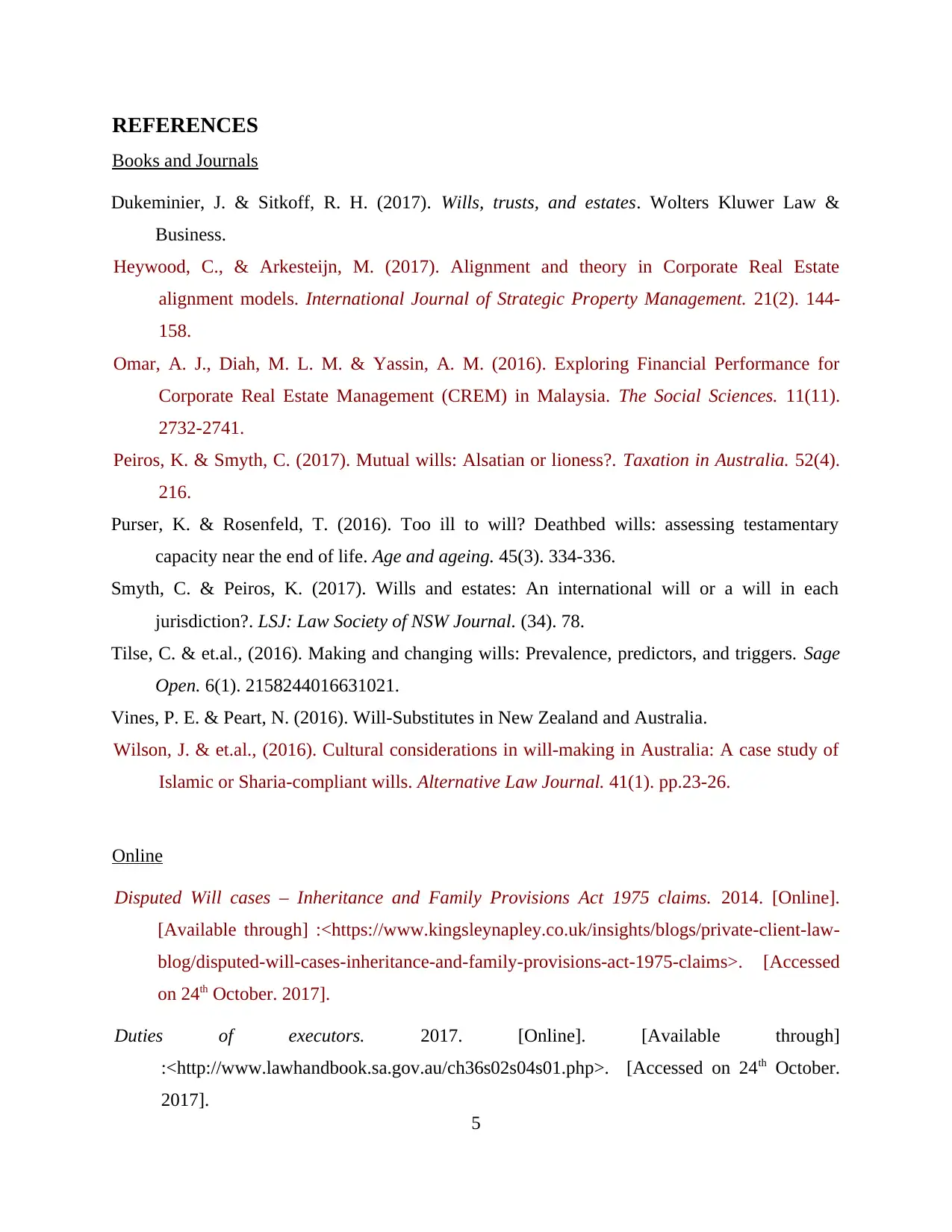
REFERENCES
Books and Journals
Dukeminier, J. & Sitkoff, R. H. (2017). Wills, trusts, and estates. Wolters Kluwer Law &
Business.
Heywood, C., & Arkesteijn, M. (2017). Alignment and theory in Corporate Real Estate
alignment models. International Journal of Strategic Property Management. 21(2). 144-
158.
Omar, A. J., Diah, M. L. M. & Yassin, A. M. (2016). Exploring Financial Performance for
Corporate Real Estate Management (CREM) in Malaysia. The Social Sciences. 11(11).
2732-2741.
Peiros, K. & Smyth, C. (2017). Mutual wills: Alsatian or lioness?. Taxation in Australia. 52(4).
216.
Purser, K. & Rosenfeld, T. (2016). Too ill to will? Deathbed wills: assessing testamentary
capacity near the end of life. Age and ageing. 45(3). 334-336.
Smyth, C. & Peiros, K. (2017). Wills and estates: An international will or a will in each
jurisdiction?. LSJ: Law Society of NSW Journal. (34). 78.
Tilse, C. & et.al., (2016). Making and changing wills: Prevalence, predictors, and triggers. Sage
Open. 6(1). 2158244016631021.
Vines, P. E. & Peart, N. (2016). Will-Substitutes in New Zealand and Australia.
Wilson, J. & et.al., (2016). Cultural considerations in will-making in Australia: A case study of
Islamic or Sharia-compliant wills. Alternative Law Journal. 41(1). pp.23-26.
Online
Disputed Will cases – Inheritance and Family Provisions Act 1975 claims. 2014. [Online].
[Available through] :<https://www.kingsleynapley.co.uk/insights/blogs/private-client-law-
blog/disputed-will-cases-inheritance-and-family-provisions-act-1975-claims>. [Accessed
on 24th October. 2017].
Duties of executors. 2017. [Online]. [Available through]
:<http://www.lawhandbook.sa.gov.au/ch36s02s04s01.php>. [Accessed on 24th October.
2017].
5
Books and Journals
Dukeminier, J. & Sitkoff, R. H. (2017). Wills, trusts, and estates. Wolters Kluwer Law &
Business.
Heywood, C., & Arkesteijn, M. (2017). Alignment and theory in Corporate Real Estate
alignment models. International Journal of Strategic Property Management. 21(2). 144-
158.
Omar, A. J., Diah, M. L. M. & Yassin, A. M. (2016). Exploring Financial Performance for
Corporate Real Estate Management (CREM) in Malaysia. The Social Sciences. 11(11).
2732-2741.
Peiros, K. & Smyth, C. (2017). Mutual wills: Alsatian or lioness?. Taxation in Australia. 52(4).
216.
Purser, K. & Rosenfeld, T. (2016). Too ill to will? Deathbed wills: assessing testamentary
capacity near the end of life. Age and ageing. 45(3). 334-336.
Smyth, C. & Peiros, K. (2017). Wills and estates: An international will or a will in each
jurisdiction?. LSJ: Law Society of NSW Journal. (34). 78.
Tilse, C. & et.al., (2016). Making and changing wills: Prevalence, predictors, and triggers. Sage
Open. 6(1). 2158244016631021.
Vines, P. E. & Peart, N. (2016). Will-Substitutes in New Zealand and Australia.
Wilson, J. & et.al., (2016). Cultural considerations in will-making in Australia: A case study of
Islamic or Sharia-compliant wills. Alternative Law Journal. 41(1). pp.23-26.
Online
Disputed Will cases – Inheritance and Family Provisions Act 1975 claims. 2014. [Online].
[Available through] :<https://www.kingsleynapley.co.uk/insights/blogs/private-client-law-
blog/disputed-will-cases-inheritance-and-family-provisions-act-1975-claims>. [Accessed
on 24th October. 2017].
Duties of executors. 2017. [Online]. [Available through]
:<http://www.lawhandbook.sa.gov.au/ch36s02s04s01.php>. [Accessed on 24th October.
2017].
5
Paraphrase This Document
Need a fresh take? Get an instant paraphrase of this document with our AI Paraphraser

Wills & Probate. 2017. [Online]. [Available through]
:<https://legalresearch.westlaw.co.uk/practice-areas/wills-probate/>. [Accessed on 24th
October. 2017].
6
:<https://legalresearch.westlaw.co.uk/practice-areas/wills-probate/>. [Accessed on 24th
October. 2017].
6
1 out of 8
Related Documents
Your All-in-One AI-Powered Toolkit for Academic Success.
+13062052269
info@desklib.com
Available 24*7 on WhatsApp / Email
![[object Object]](/_next/static/media/star-bottom.7253800d.svg)
Unlock your academic potential
Copyright © 2020–2025 A2Z Services. All Rights Reserved. Developed and managed by ZUCOL.




